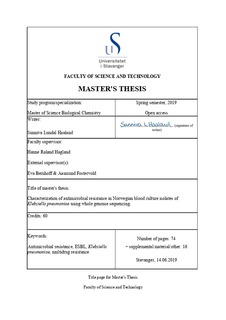| dc.description.abstract | Antimicrobial drugs are used to treat and prevent infections caused by microorganisms. For decades, they have saved millions of lives, treated diseases and reduced pain. However, when exposed to antimicrobial drugs, microorganisms develop antimicrobial resistance (AMR) over time. This process is accelerated by the misuse and overuse of antibiotics. To handle this global health threat has become a high priority by WHO.
Klebsiella pneumoniae is a common intestinal bacterium that can cause life-threatening infections, such as pneumonia, wound, soft tissue or urinary tract infections. It is an important reservoir for a number of AMR-genes. K. pneumoniae can acquire extended-spectrum β- lactamase (ESBL) encoding genes which lead to resistance against broad-spectrum cephalosporins. K. pneumoniae is the ‘K’ in the ESKAPE pathogens, which is the six most significant and dangerous causes of drug-resistant hospital infections identified by the Infectious Diseases Society of America.
In this study, antimicrobial resistance determinants and presence of multidrug resistance in a population of 722 K. pneumoniae isolates were identified using Illuminas MiSeq WGS technology and several bioinformatics tools. It was taken particular interest in third- generation cephalosporins, aminoglycosides, fluoroquinolones, trimethoprim/ sulfamethoxazole and colistin. Detected resistance determinants were compared to detected phenotypical antimicrobial susceptibility, determined by micro broth dilution. This was done for a selection of isolates containing extended-spectrum β-lactamase genes or colistin resistance determinants.
K. pneumoniae sensu stricto was found to be the most prevalent species in this population of 722 isolates. A high diversity of sequence types (STs) was detected (n=378), where ST107 was the most prevalent (n=67).
20.5% (n=148) of this population had determinants encoding resistance to at least one of the drug classes investigated. Five isolates were found with genotypic colistin resistance due to truncations of PmrB and MgrB. ESBLA-genes were detected in 50 isolates, where blaCTX-M-15 (n=34) was the dominant ESBLA-gene. ST307 containing blaCTX-M-15 was the dominant ESBLA carrying sequence type (n=11).
46 isolates were found to be multidrug resistant, mainly to aminoglycosides, fluoroquinolones and trimethoprim/ sulfamethoxazole. However also strongly associated with carriage of ESBLA, predominantly blaCTX-M-15.
Based on the results, genotype cannot reliably predict phenotype for all the tested drug classes. However, presence of ESBLA-genes coincides with phenotypic resistance against third-generation cephalosporins, indicating ability to predict a resistant phenotype. | nb_NO |

